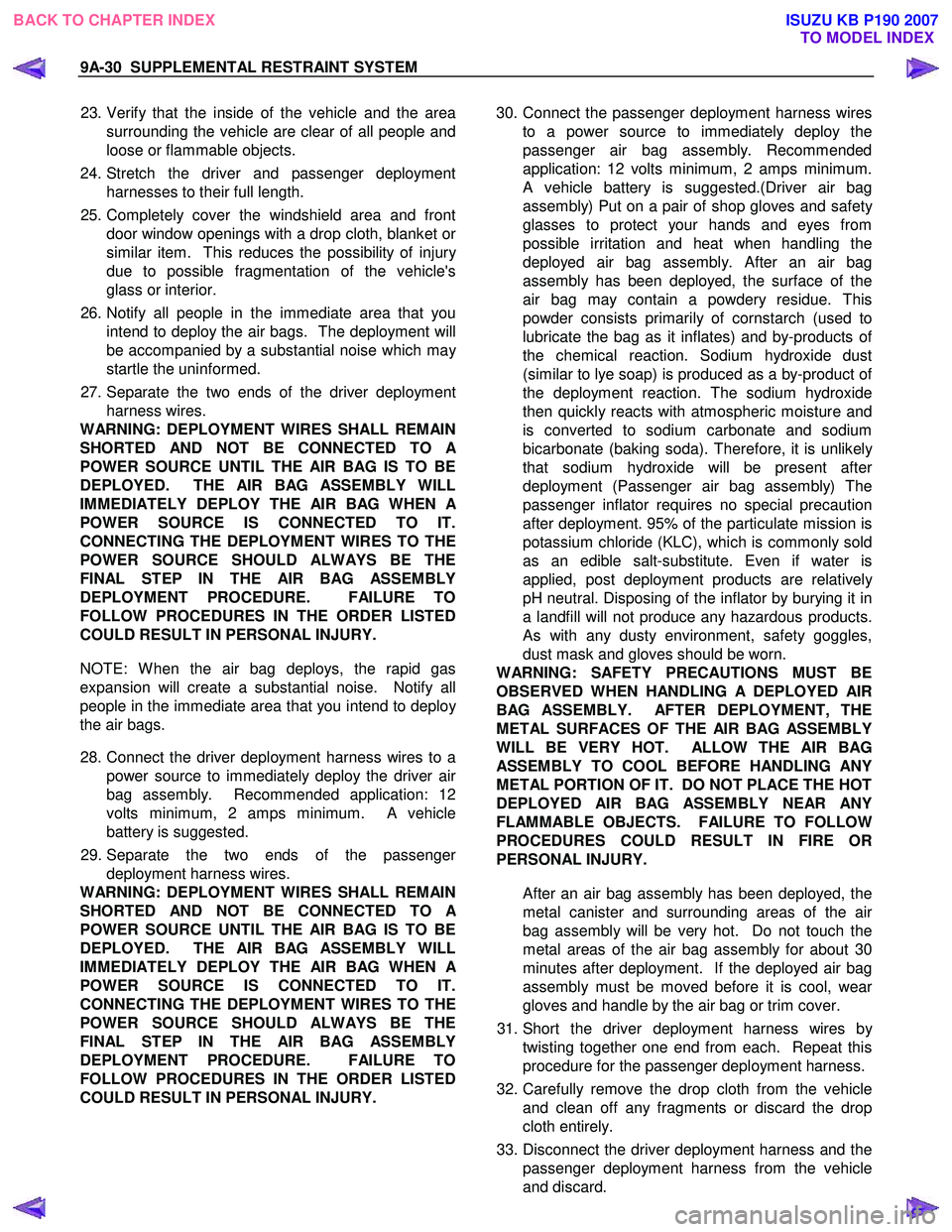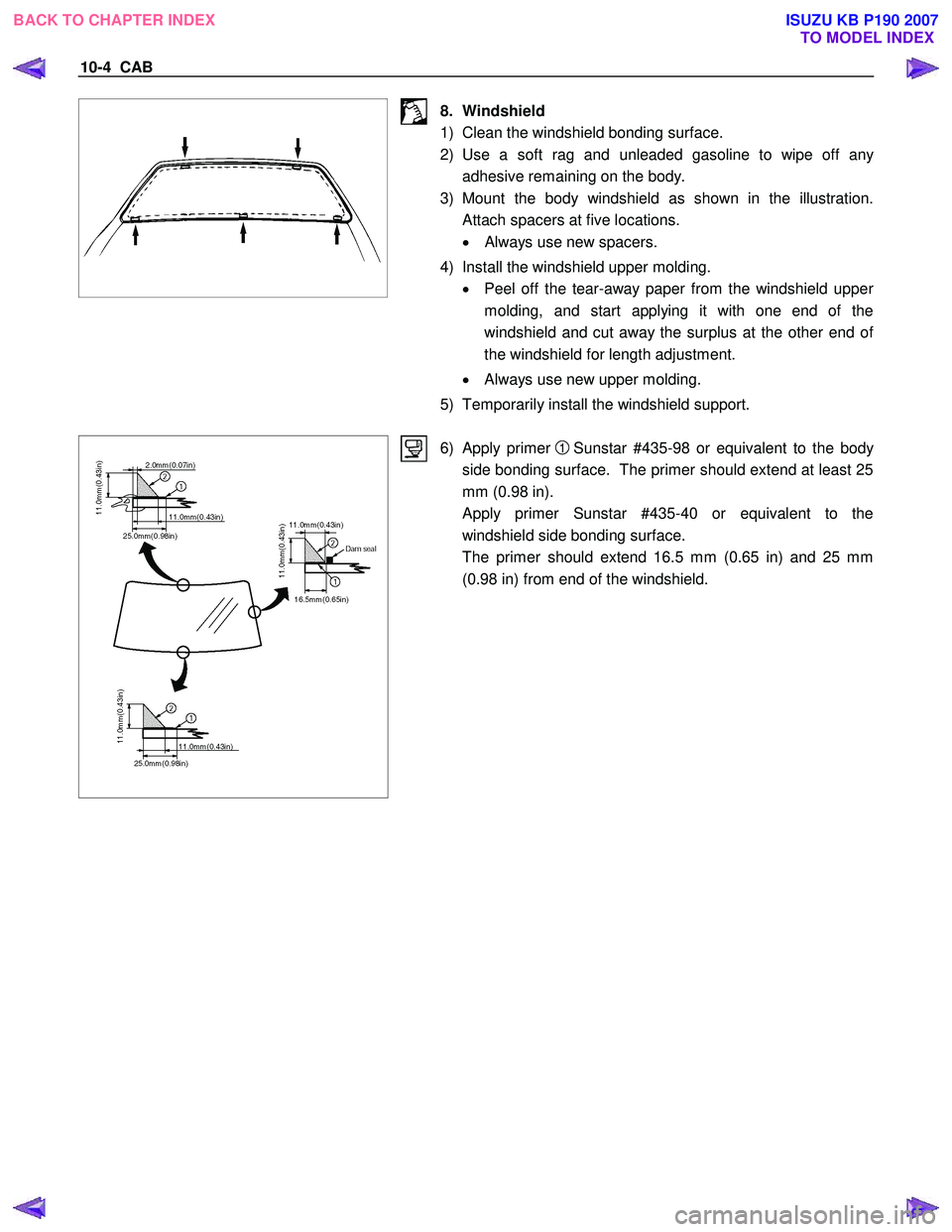2007 ISUZU KB P190 length
[x] Cancel search: lengthPage 5662 of 6020

SUPPLEMENTAL RESTRAINT SYSTEM 9A-27
5. Remove the passenger air bag assembly from the
vehicle. Refer to “Passenger Air Bag Assembl
y
Removal “.
6. Clear a space on the ground approximately 183 cm (six feet) in diameter where the fixture with
attached air bag assembly is to be placed fo
r
deployment. A paved outdoor location where there
is no activity is preferred. If an outdoor location is
not available, a space on the shop floor where
there is no activity and there is sufficient ventilation
is recommended. Ensure that no loose o
r
flammable objects are within the deployment area.
7. Place the 5-8840-2420-0 on the bench vise. This is necessary to provide sufficient stabilization o
f
the fixture during deployment.
8. Attach the passenger air bag assembly in the 5- 8840-2420-0. The air bag assembly must be
mounted such that the bag will deploy upward.
SECURELY HAND–TIGHTEN ALL FASTENERS
PRIOR TO DEPLOYMENT.
RTW 79ASH000601
9. Stretch the SRS Deployment Harness and pigtail
adapter from the air bag assembly to its full length.
10. Place a power source near the shorted end of the SRS deployment harness. (Recommended
application: 12 volts minimum, 2 amps minimum.
A vehicle battery is suggested.)
11. Connect the air bag assembly to the pigtail adapte
r
on the SRS deployment harness. The SRS
Deployment Harness shall remain shorted and not
be connected to a power source until the air bag is
to be deployed. The air bag assembly will
immediately deploy the air bag when a powe
r
source is connected to it.
NOTE: Ensure that the pigtail adapter is firmly seated
into the air bag assembly connector. Failure to full
y
seat the connectors may leave the shorting bar located
in the air bag assembly connector functioning (shorting
the deployment circuit) and may result in no
deployment of the air bag assembly.
12. Verify that the area around the passenger air bag assembly is clear of all people and loose o
r
flammable objects.
13. Verify that the passenger air bag assembly is firmly and properly in the 5-8840-2420-0.
14. Notify all people in the immediate area of you
r
intention to deploy the passenger air bag
assembly. The deployment will be accompanied
by a substantial noise which may startle the
uninformed.
15. Separate the two banana plugs on the SRS deployment harness.
NOTE: W hen the air bag deploys, the driver air bag
assembly may jump about 30 cm (one foot) vertically.
This is a normal reaction of the driver air bag to the
force of the rapid gas expansion inside the air bag.
NOTE: W hen the air bag deploys, the rapid gas
expansion will create a substantial noise. Notify all
people in the immediate area that you intend to deplo
y
the air bag assembly.
WARNING: THE DEPLOYMENT HARNESS SHALL
REMAIN SHORTED AND NOT BE CONNECTED TO
A POWER SOURCE UNTIL THE AIR BAG IS TO BE
DEPLOYED. THE AIR BAG ASSEMBLY WILL
IMMEDIATELY DEPLOY THE AIR BAG WHEN
A
POWER SOURCE IS CONNECTED TO IT.
CONNECTING THE DEPLOYMENT HARNESS TO
THE POWER SOURCE SHOULD ALWAYS BE THE
LAST STEP IN THE AIR BAG ASSEMBLY
DEPLOYMENT PROCEDURE. FAILURE TO
FOLLOW PROCEDURES IN THE ORDER LISTED
MAY RESULT IN PERSONAL INJURY.
16. Connect the SRS deployment harness wires to the power source to immediately deploy the air bag
assembly. Recommended application : 12 volts
minimum, 2 amps minimum. A vehicle battery is
suggested.
17. Disconnect the SRS deployment harness from the power source.
18. Short the two SRS deployment harness leads together by fully seating one banana plug into the
other.
19. In the unlikely event that the passenger air bag assembly did not deploy after following these
procedures, proceed immediately with Steps 24
through 26. If the passenger air bag assembl
y
deployed as intended, proceed with Steps 20
through 23.
BACK TO CHAPTER INDEX TO MODEL INDEXISUZU KB P190 2007
Page 5665 of 6020

9A-30 SUPPLEMENTAL RESTRAINT SYSTEM
23. Verify that the inside of the vehicle and the area
surrounding the vehicle are clear of all people and
loose or flammable objects.
24. Stretch the driver and passenger deployment harnesses to their full length.
25. Completely cover the windshield area and front door window openings with a drop cloth, blanket o
r
similar item. This reduces the possibility of injury
due to possible fragmentation of the vehicle's
glass or interior.
26. Notify all people in the immediate area that you intend to deploy the air bags. The deployment will
be accompanied by a substantial noise which ma
y
startle the uninformed.
27. Separate the two ends of the driver deployment harness wires.
WARNING: DEPLOYMENT WIRES SHALL REMAIN
SHORTED AND NOT BE CONNECTED TO
A
POWER SOURCE UNTIL THE AIR BAG IS TO BE
DEPLOYED. THE AIR BAG ASSEMBLY WILL
IMMEDIATELY DEPLOY THE AIR BAG WHEN
A
POWER SOURCE IS CONNECTED TO IT.
CONNECTING THE DEPLOYMENT WIRES TO THE
POWER SOURCE SHOULD ALWAYS BE THE
FINAL STEP IN THE AIR BAG ASSEMBLY
DEPLOYMENT PROCEDURE. FAILURE TO
FOLLOW PROCEDURES IN THE ORDER LISTED
COULD RESULT IN PERSONAL INJURY.
NOTE: W hen the air bag deploys, the rapid gas
expansion will create a substantial noise. Notify all
people in the immediate area that you intend to deplo
y
the air bags.
28. Connect the driver deployment harness wires to a power source to immediately deploy the driver ai
r
bag assembly. Recommended application: 12
volts minimum, 2 amps minimum. A vehicle
battery is suggested.
29. Separate the two ends of the passenge
r
deployment harness wires.
WARNING: DEPLOYMENT WIRES SHALL REMAIN
SHORTED AND NOT BE CONNECTED TO
A
POWER SOURCE UNTIL THE AIR BAG IS TO BE
DEPLOYED. THE AIR BAG ASSEMBLY WILL
IMMEDIATELY DEPLOY THE AIR BAG WHEN
A
POWER SOURCE IS CONNECTED TO IT.
CONNECTING THE DEPLOYMENT WIRES TO THE
POWER SOURCE SHOULD ALWAYS BE THE
FINAL STEP IN THE AIR BAG ASSEMBLY
DEPLOYMENT PROCEDURE. FAILURE TO
FOLLOW PROCEDURES IN THE ORDER LISTED
COULD RESULT IN PERSONAL INJURY.
30. Connect the passenger deployment harness wires
to a power source to immediately deploy the
passenger air bag assembly. Recommended
application: 12 volts minimum, 2 amps minimum.
A vehicle battery is suggested.(Driver air bag
assembly) Put on a pair of shop gloves and safet
y
glasses to protect your hands and eyes from
possible irritation and heat when handling the
deployed air bag assembly. After an air bag
assembly has been deployed, the surface of the
air bag may contain a powdery residue. This
powder consists primarily of cornstarch (used to
lubricate the bag as it inflates) and by-products o
f
the chemical reaction. Sodium hydroxide dust
(similar to lye soap) is produced as a by-product o
f
the deployment reaction. The sodium hydroxide
then quickly reacts with atmospheric moisture and
is converted to sodium carbonate and sodium
bicarbonate (baking soda). Therefore, it is unlikel
y
that sodium hydroxide will be present afte
r
deployment (Passenger air bag assembly) The
passenger inflator requires no special precaution
after deployment. 95% of the particulate mission is
potassium chloride (KLC), which is commonly sold
as an edible salt-substitute. Even if water is
applied, post deployment products are relativel
y
pH neutral. Disposing of the inflator by burying it in
a landfill will not produce any hazardous products.
As with any dusty environment, safety goggles,
dust mask and gloves should be worn.
WARNING: SAFETY PRECAUTIONS MUST BE
OBSERVED WHEN HANDLING A DEPLOYED AIR
BAG ASSEMBLY. AFTER DEPLOYMENT, THE
METAL SURFACES OF THE AIR BAG ASSEMBLY
WILL BE VERY HOT. ALLOW THE AIR BAG
ASSEMBLY TO COOL BEFORE HANDLING ANY
METAL PORTION OF IT. DO NOT PLACE THE HOT
DEPLOYED AIR BAG ASSEMBLY NEAR ANY
FLAMMABLE OBJECTS. FAILURE TO FOLLOW
PROCEDURES COULD RESULT IN FIRE OR
PERSONAL INJURY.
After an air bag assembly has been deployed, the
metal canister and surrounding areas of the ai
r
bag assembly will be very hot. Do not touch the
metal areas of the air bag assembly for about 30
minutes after deployment. If the deployed air bag
assembly must be moved before it is cool, wea
r
gloves and handle by the air bag or trim cover.
31. Short the driver deployment harness wires b
y
twisting together one end from each. Repeat this
procedure for the passenger deployment harness.
32. Carefully remove the drop cloth from the vehicle and clean off any fragments or discard the drop
cloth entirely.
33. Disconnect the driver deployment harness and the passenger deployment harness from the vehicle
and discard.
BACK TO CHAPTER INDEX TO MODEL INDEXISUZU KB P190 2007
Page 5762 of 6020

10-4 CAB
8. Windshield
1) Clean the windshield bonding surface.
2) Use a soft rag and unleaded gasoline to wipe off an
y
adhesive remaining on the body.
3) Mount the body windshield as shown in the illustration. Attach spacers at five locations.
• Always use new spacers.
4) Install the windshield upper molding. • Peel off the tear-away paper from the windshield uppe
r
molding, and start applying it with one end of the
windshield and cut away the surplus at the other end o
f
the windshield for length adjustment.
• Always use new upper molding.
5) Temporarily install the windshield support.
6) Apply primer
1 Sunstar #435-98 or equivalent to the body
side bonding surface. The primer should extend at least 25
mm (0.98 in).
Apply primer Sunstar #435-40 or equivalent to the windshield side bonding surface.
The primer should extend 16.5 mm (0.65 in) and 25 mm (0.98 in) from end of the windshield.
BACK TO CHAPTER INDEX TO MODEL INDEX
ISUZU KB P190 2007
Page 5862 of 6020

IMMOBILIZER CONTROL SYSTEM (4JK1/4JJ1/HFV6) 11A-11
Security Wait Time
This parameter displays the security wait time length in
the ICU. Inactive indicates not in security wait time.
Time indicates under security wait time. This wait time
stage will prevent any further attempts to enter the
security code until the wait time has elapsed. The wait
time will increase each time an incorrect security code
is entered. Note that this parameter is not count
downed. It keeps displaying the same time until that
wait time has elapsed. The ignition switch must be kept
at ON position during the wait time period.
While Security Lock
This parameter displays the state of the security wait
time. Inactive indicates not in security wait time. Active
indicates under security wait time.
BACK TO CHAPTER INDEX TO MODEL INDEX
ISUZU KB P190 2007